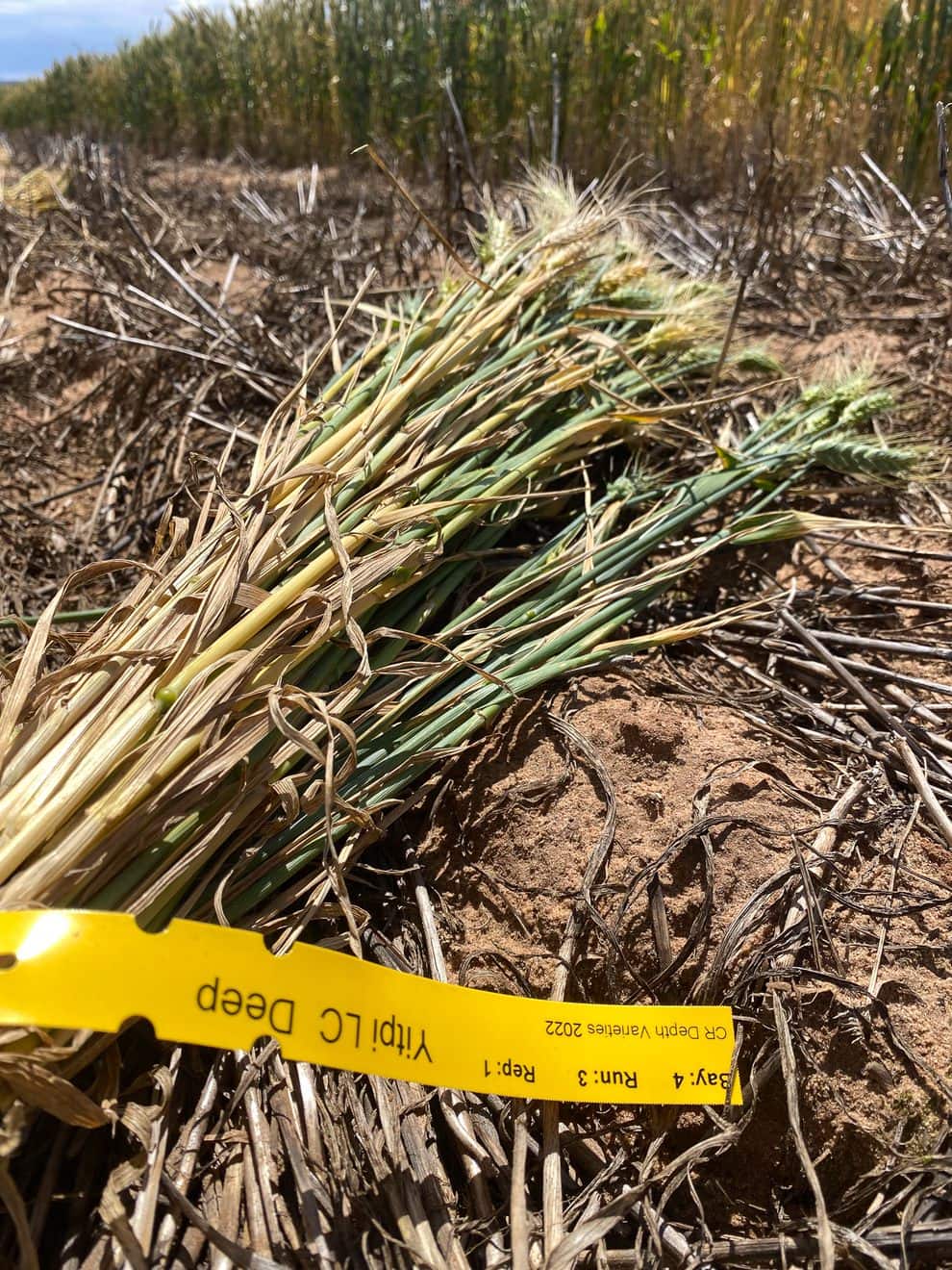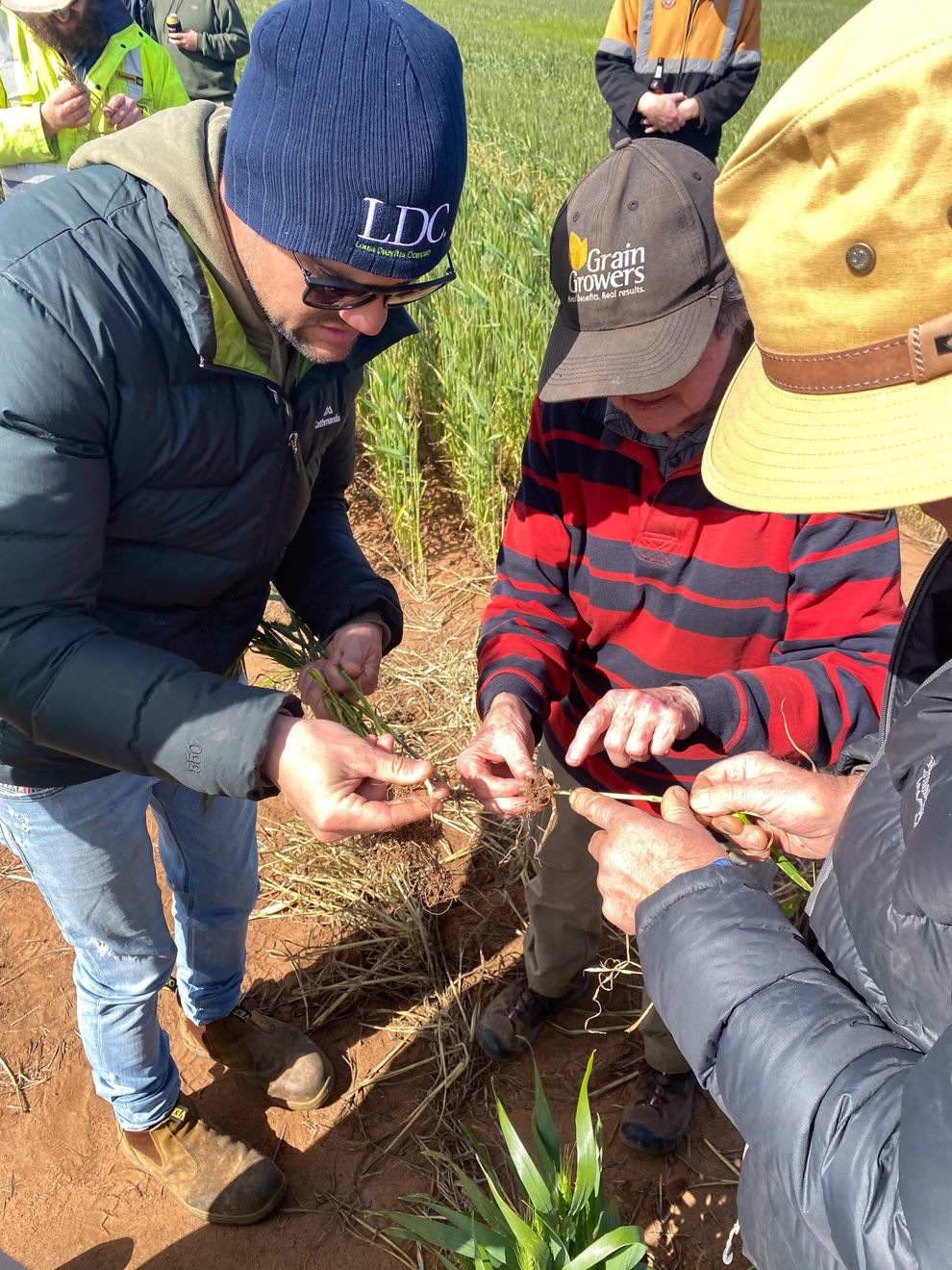Managing crown rot on upper EP – a joint learning experience
Project Plan
Project activities will build on knowledge gained from prior research on Upper EP using trials and complementary grower-sown demonstrations with the objectives being to:
1. Reduce yield losses due to crown rot, so increasing the amount and consistency of grain quantities available for export.
2. Improve the consistency of cereal grain production and the profitability of cereal enterprises on UEP.
3. Increase adoption of existing (used in conventional and novel ways) and novel options for managing crown rot.
4. Improve the ability of farmers and advisors (and researchers) to understand trials and demonstrations and how to interpret the results for application and implementation in local farming systems.
2022 Field Trials Take-home messages
Field trials and demonstrations were established at Buckleboo and Mitchellville on Upper Eyre Peninsula, with an Elders-funded matching trial in the Upper North at Booleroo Centre, value-adding to the SAGIT project.
Mild conditions during flowering and grain filling meant there was no white head expression due to crown rot, although basal stem browning was present.
There were small, statistically significant average yield improvements at Mitchellville (3%) and Booleroo Centre (7%) where Victratoâ fungicide was applied to seed, but there were no variety:fungicide interactions.
In general, bread wheat entries included for their (possibly) improved resistance to crown rot had lower yields than other entries.
In a season with high soil moisture at sowing, sowing deep to “chase moisture” reduced yield (by 5%) of four long coleoptile varieties but did not affect yield of Calibre (longer coleoptile).
Information about the project and its findings were provided to Industry during crop walks at the Buckleboo and Mitchellville sites and, at their request, at the Baroota UNFS crown rot management site.
A tailored, field-based capacity building activity based around cereal root and stem-base diseases resulted in a wide range of learnings for participants.
Successful in-field evaluation of the above activity provided a joint learning experience for the presenter and participants. As a result, a tailored activity has been designed for growers and a process developed to trial for improving the capability and confidence of participants in identifying cereal root and stem-base diseases.
The project and its findings were publicised outside Eyre Peninsula by presenting at a UNFS crown rot management trial at Baroota and by running a modified cereal root and stem-base diseases activity at the Hart twilight walk.
Industry capacity to undertake crown rot research was improved by assisting and providing training for those running crown rot trials for the Hart Field Site Group and the Upper North Farming Systems group. This included visual assessment of treatment plots, taking plant samples, counting white heads, processing samples and scoring basal stem browning.
2023 Field Trials Take-home messages
A total of 5 replicated trials and two large-plot demonstrations were established at Buckleboo and Mitchellville on Upper Eyre Peninsula in 2023.
Limited moisture stress during flowering and grain filling in 2023 resulted in some basal stem browning as well as some white head expression due to crown rot.
Positive average yield responses to VICTRATOÒ were seen in bread wheat (1%-11%) and barley (7%-12%) in 2022 and 2023, despite limited crown rot expression. This is consistent with lower-end responses at medium and high rainfall sites in South Australia.
Visual inspection of 2023 data and statistical analysis of 2022 data indicates that varietal responses to VICTRATOâ will be similar, regardless of varietal maturity and resistance rating.
These findings make VICTRATOâ a useful addition to the strategies currently available for crown rot management. It is clear VICTRATOâ should not be used as a stand-alone option, but will best be pyramided with other management options where there is a known risk of yield loss from crown rot.
Yield improvements due to VICTRATO® won’t produce the yield that could be achieved in the absence of crown rot and you may still see white heads where VICTRATO® is applied.
At Mitchellville in 2023, a combination of season, soil and site conditions disadvantaged the barley yield response (average 22% yield decrease) to VICTRATOâ due to good early growth promoted by VICTRATOâ in the presence of crown rot. This result was unexpected and is unlikely to occur often in barley and rarely in bread wheat due to their different tillering habits.
Consider the economics of VICTRATOâ using t/ha responses. For example (Scepter) – a 10% yield improvement at Buckleboo in 2022 (untreated yield = 3.91 t/ha) = 0.39 t/ha but in 2023 (untreated yield = 1.56 t/ha) = 0.15 t/ha. No difference in % yield change (which is used to compare across sites, years and treatments) but a big difference in economics.
VICTRATOâ slightly reduces severity but not visual incidence of crown rot on main stem bases which suggests a large reduction in inoculum carryover is unlikely. To better understand this effect of VICTRATOâ, dedicated trials were established in 2023 and crown rot risk levels will be assessed in 2024 using PREDICTAâ B.
Share this project:
You Might Also Like
Retaining soil water in farming systems using strip & disc machinery 2024
This project would enable one demonstration site to be conducted in low rainfall farming systems at Buckleboo to enable extension of past EP demonstration site results and results from other…
Learn MoreFurther tactics to minimise frost damage on the Eyre Peninsula
Previous frost work on the EP has been well received and has assisted in filling key agronomic knowledge gaps around frost mitigation in crop, however, it has been identified that…
Learn MoreSilicon: a novel solution to reduce water use and pest damage in wheat
Quantify how silicon fertilisation increases water use efficiency and pest resistance in wheat at the field scale with agronomic practices in place, including farm settings with contrasting agricultural landscapes.…
Learn MoreA needs analysis for the barriers to adoption of strip and disc systems on Eyre Peninsula
Identify the risks and opportunities (including a cost benefit analysis) faced by growers using Strip and Disc systems to determine any gaps in knowledge to be addressed for this practice…
Learn MoreDelivery of the Sustainable Agriculture Facilitator (SAF)
The Sustainable Agriculture Facilitator (SAF) is a designated central contact point for farmers, landholders, industry, and community groups and will aim to support sustainable agriculture practices in Eyre Peninsula. The…
Learn MoreVirtual Fencing for improved climate resilience on South Australian farms
This project will continue the work of initial trials to look at the use of virtual fencing technology in a new field site on the Eyre Peninsula to look at…
Learn MoreSA Young Farmer – Facilitated Peer to Peer Learning
To share innovative ways to build drought resilience and build local leadership, networks, and social support In Ceduna and Cleve locations AIR EP will offer four field events for young…
Learn MoreSA Eyre Peninsula Coordination FRRR Community Impacts Grants
To strengthen drought preparedness and drive local action in the Eyre Peninsula region through the coordination of Community Impact Program activities and evaluation administration. Bi-monthly meetings between key delivery partners,…
Learn MoreImproving the climate resilience of the Australian Sheep Flock
Project activities include • Demonstration of practical strategies which improve the fertility of sheep joined during summer • Collation and communication of results from management trials • Demonstration of the…
Learn MoreBuilding farming systems resilience and future proofing the impacts of drought through accelerating the adoption of proven cost-effective and yield responsive soil and fertiliser management practices by farmers across southern Australia
The project focuses on accelerating adoption of proven soil resource management practices offering significant opportunity to build farming systems drought resilience, reduce yield variability, increase sustainability and profitability. These practices…
Learn More

